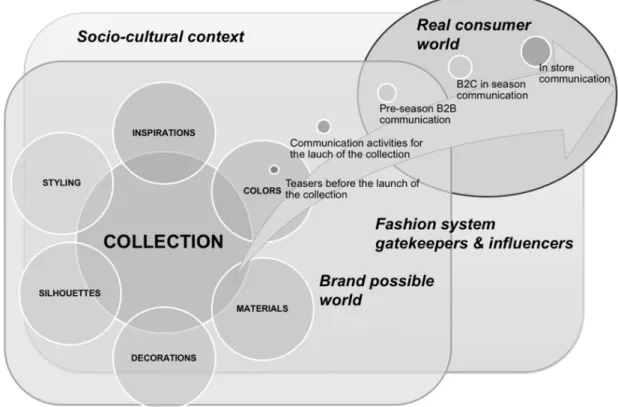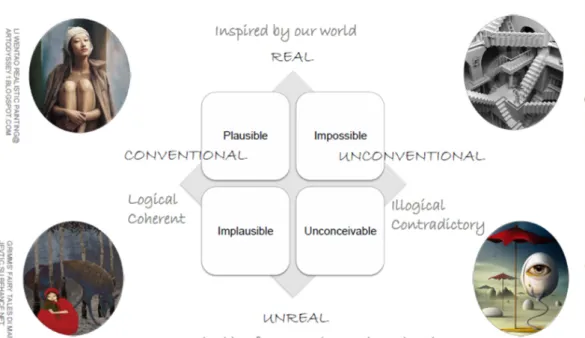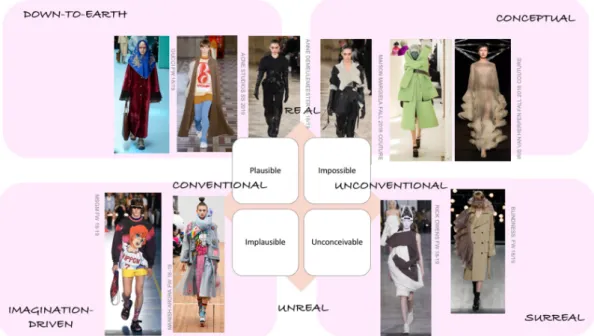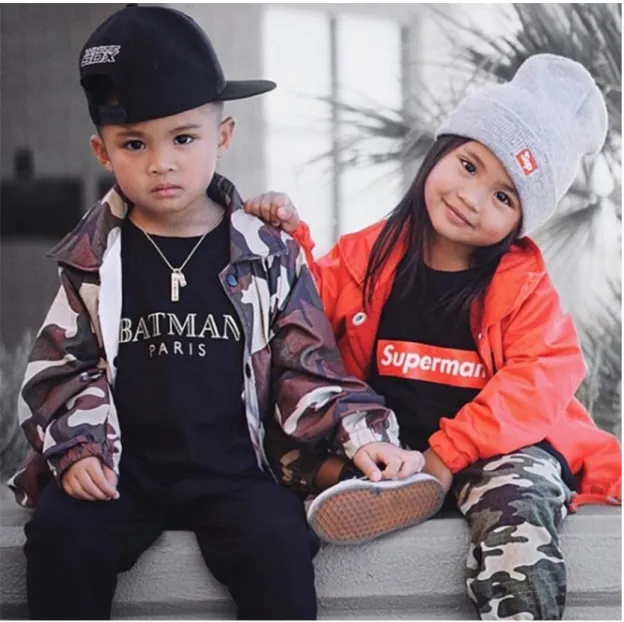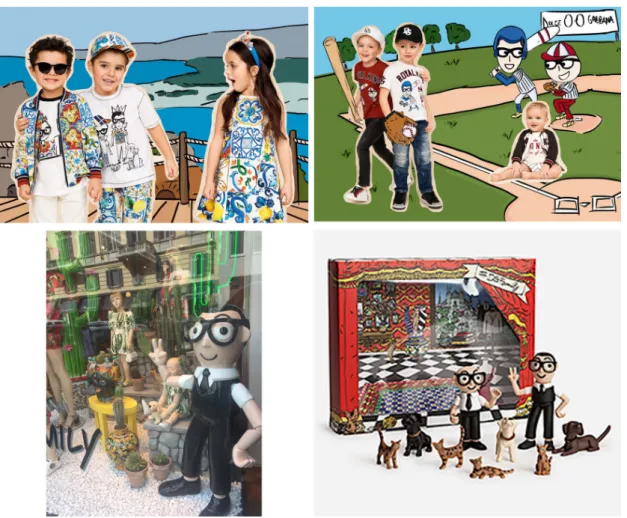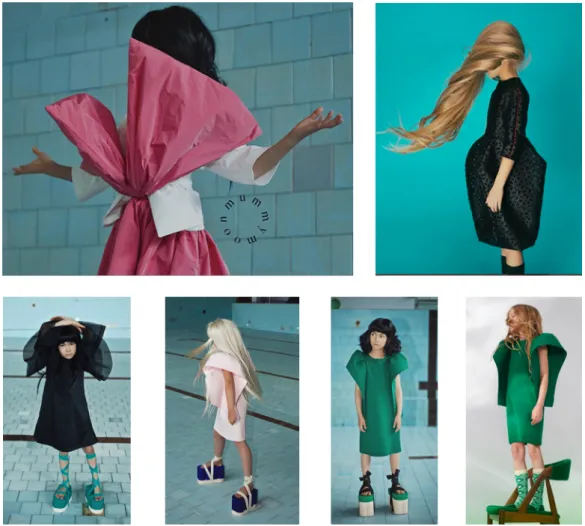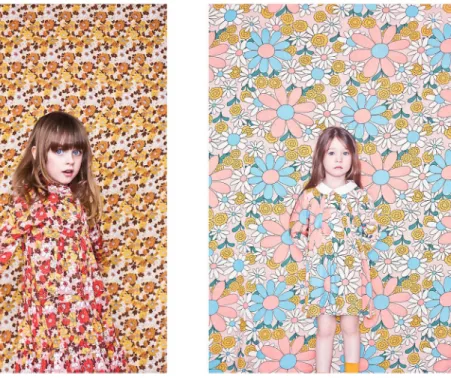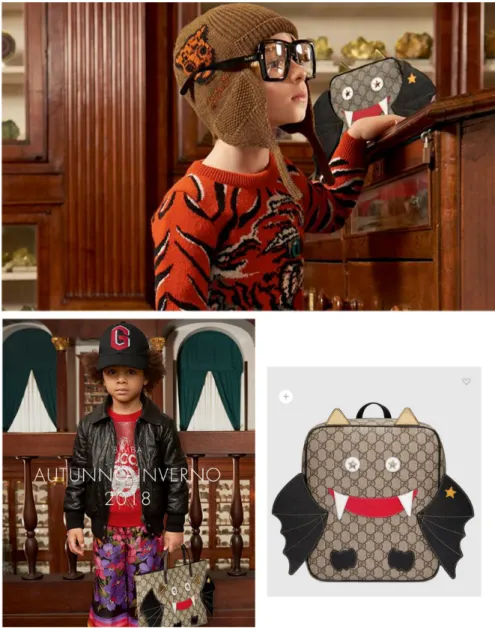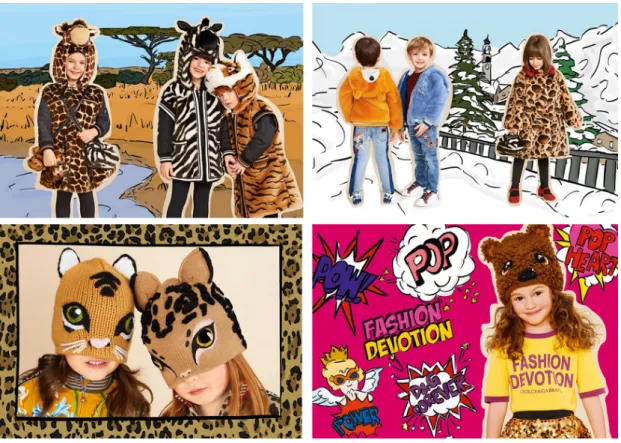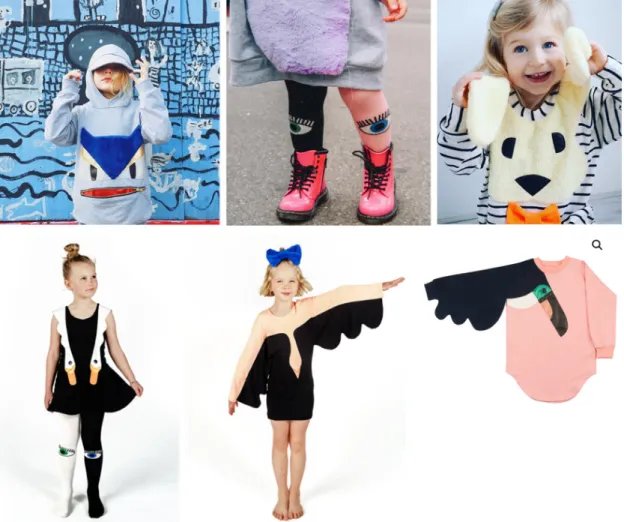Alphas Storytelling: Mapping Childrenswear Possible
Worlds, Defining Seasonal Brands Territories
Simona Ironico
Published: December 21, 2018
Abstract
Born from 2010 and raised by Millennials, Alphas represent today the youngest generational market segment. Raising as “screenagers” in mostly only-child family environments, technology is shaping their present and future consumer culture. In this scenario, contemporary trends such as hyper indi-vidualism, instant gratification, gamification, gender fluidity, slow play, sustainability and reconnec-tion with nature are destined to reach their apotheosis. The paper adopts the socio-semiotic interpre-tative framework of “Possible Worlds” to map the rich set of narratives generated by childrenswear collections and communication strategies. Comparing inspirations and aesthetics, four storytelling approaches will be discussed: Down to Earth (Plausible Worlds), Imagination Driven (Implausible Worlds), Conceptual (Impossible Worlds) and Surreal (Unconceivable Worlds). In addition to reveal contemporary trends and seasonal brand territories, the analysis of kidswear “fashion tales” will en-able to get important insights about Alphas unripe consumer culture.
Keywords: Generational Marketing; Childrenswear; Creative and Design Direction; Possible Worlds; Fashion Tales.
Simona Ironico:Istituto Marangoni (Italy) [email protected]
She is an experienced academic with a Ph.D. in Marketing and Business Communication. Since 2016, she is in charge of the Fashion Business department at Istituto Marangoni Milan as Programme Leader. Simona Ironico gain her experience at Iulm University, Università degli Studi di Modena e Reggio Emilia, and Istituto Marangoni lectur-ing and carrylectur-ing out research in the domains of fashion management, sociology of fashion, consumer behaviour, trend forecasting, marketing communications and brand management. The results of her research activity, charac-terized by a socio-semiotic interpretative approach and ethnographic research methods, are regularly presented at international conferences, seminars, symposia and trend forums. She is author of several papers published in scien-tific journals and other academic publications, including a book on children consumer behavior – Come i Bambini diventano Consumatori (Laterza 2010) – and a fashion management handbook – Fashion Management. Mercati, consumatori, tendenze e strategie di marca nel settore moda (Franco Angeli, 2014).
The en Alpha ra
Once upon a time, there were children and teenagers. Now, everything is about “Alphas”.
Not so long time ago, age was the most popular criteria for segmenting young consumers, enabling to get (still) useful groups as new-born, baby (or toddler), kid, teen and junior. Furthermore, the late 90s label of “tweens” — the segment between children and adolescents — risks to sound old fashion today. However, even in the era when generational marketing has reached its peak in popularity, we cannot deny the value of the pivotal multidimensional approach by James McNeal,1segmenting young consumers in primary, secondary, influence and future market.
A primary market is made by consumers able to act as economic agents,2performing the role of buyers. The economic agent status cannot normally be achieved before the age of 8, with the learning of the basic knowledge and skills to autonomously carry out a purchase act, particularly how to use money and how to behave in the stores.3
In the contemporary “influencers” economy, dealing with influence markets can sound really appealing. Or, paradoxically, misleading. Within the theoretical framework of the “Innovation life-cycle,”4 influ-encers belong to the “Early Adopters” consumer segment, namely that 13,5% of the market characterized by high levels both of innovativeness and personal influence. Including opinion leaders as fashion editors and life-style leaders as celebrities and Instagrammers, Early Adopters tend to accept innovations — new ideas, new products, new brands, new styles — before the other members of their social system. More-over, they typically affect other people (consumer) attitudes and behaviors. More cautious and selective than the “Innovators” segment — the most edgy, experimental and avant-garde 2,5% of the market, nat-urally attracted by new concepts and adopting innovations before anybody else — Early Adopters play a vital role in the diffusion of trends. Indeed, their consumer choices can easily “click” to the mainstream taste of the market, leading fashion followers — Early Majority and Late Majority — to emulate them. Considering that such segments approximately cover the 70% of the market, Early Adopters have the power to convert emerging trends into high sales volumes. Since contemporary technology enables to effortlessly measure influence through metrics as the number of followers or Like (the so-called “engage-ment”), the appeal of “people from nowhere” as Instagrammers and Youtubers, today, is higher than ever.
Early Adopters obviously do exist in young consumers markets as well. The phenomenon of Baby Alpha Influencers, with less than four-year-old children — and including even less than one-year-old ones! — as style leaders, clearly demonstrates that. It’s the case, just to cite a few names, of Mad-dox Jax Melchico-Bronx (currently nine-month-old, 4.3k Instagram followers @iammaMad-doxjax), Mason Ely (ten-months-old, 7.8k followers @masons.world_), London (one-year-old, 12,4k followers @baby-londonsworld), Mark Hardin (two-year-old, 15.1k followers @sk8ing_toddler), Iman Tayla Shumpert Jr (two-year-old, 371k followers @babyjunie4), Quenisha Qiana (two-year-old, 229k followers @quen-isha.qiana) or Seza (four-year-old, 5.8k followers @yildiz_seza). Typically models or sons of adult in-fluencers, Baby Alpha Influencers can become real stars, as Farouk James (six years old, 207k followers @faroukjames) or Zooey Miyoshi (six years old, 137.7k followers@zooeyinthecity), both famous since the age of two.
Influence, however, represents a structural trait of young consumers markets, regardless of the status of kids as fashion leaders or fashion followers. In other words, even late majority and laggards — the seg-ments less sensitive to innovation, adopting trends later than average consumers — are influence markets.
1. James Umbert McNeal, Children as Consumers (Austin: Bureau of Business Research, University of Texas at Austin, 1964). 2. Anna Emilia Berti and Anna Silvia Bombi. The Child’s Construction of Economics (New York: Cambridge University Press,
1988).
3. James Umbert McNeal, On Becoming a Consumer. Development of Consumer Behavior Patterns in Childhood (Oxford: Elsevier, 2007).
According to Consumer Development perspective,5an influence market is made by consumers able to affect the outcome of a buying process carried out by another subject. Young consumers typically repre-sent an influence market because, even if unable or not allowed to autonomously carry out a purchase act, they are able to exert an influence on the purchases of their families, by expressing their needs and asserting their preferences.
The notion of future market, to conclude, is not related to the different roles young consumers may play in the purchase process (decision-maker, buyer, user, influencer), but to the strategic orientation of brands. Hence, children are a future market when companies invest into long-term activities aimed at encouraging the brand loyalty of children as the consumers of tomorrow, in a lifetime relationship marketing view. And that’s the point of generational marketing: we need to follow — another popular keyword today — our consumers. We probably forgot the moment when the youngsters started not to be the Millennials anymore to be replaced by Generation Z (for the record, Millennials entered parent-hood approximately 10 years ago and are now raising Alphas). In the continuous flow of Postmodernity, consumers are evolving faster and faster, and even age groups have become liquid.
If we desire a snapshot of the contemporary children market, Children — today — are Alphas. But don’t get used to this label too much. Children will move fast into something else (Beta?), and Alphas will enter the next stage. Tweens? Maybe, but, as I said, the label it’s already old fashion.
The unripe Alpha consumer culture
Generation Alpha represent today the youngest consumer cohort, including the boys and girls of the recent past and the forthcoming future, born between 2010 and 2025. Their year of birth immediately reconnects Alphas to technology: 2010 was the year the iPad was launched, Instagram was created and “app” was elected as the word of the year. Alphas are the first generation raised on augmented reality, virtual reality, artificial intelligence and, for them, such technologies will soon become the norm, and not novelty.6 Raising as “screenagers” in mostly only-child family environments, their present and future consumer culture is being shaped by the more than ever rapid peace of innovation. In this scenario, contemporary trends such as hyper individualism, instant gratification, gamification, gender fluidity, slow play, sustainability and reconnection with nature are destined to reach their apotheosis.
According to WGSN Consumer Insight,7the world created by their Millennial parents is making Alphas accustomed to a “bespoke” world. Indeed, they are growing up
in an era of individualization and customization, one where Netflix knows exactly what they want to watch next and where everything from their storybooks and Nutella jars are personalized. While this may be a novelty for older generations, a world of uniquely-tailored experiences is what Alphas have grown up expecting.8
Destined to be even more cultivated and materially-endowed than their Millennials parents and Gen Z older brothers and sisters, “they will probably place less value on ’stuff”9and embrace more sustainable life-styles. Moreover, exposed to the challenges coming from Artificial Intelligence, they will be oriented to value more self-expression, creativity and imperfection.
5. See McNeal, On Becoming a Consumer; Simona Ironico, Come i bambini diventano consumatori (Roma-Bari: Laterza, 2010).
6. WGSN Consumer Insight, “Modern Language: How to Speak Alpha,” WGSN, June 6, 2017. 7. WGSN Consumer Insight, “Modern Language: How to Speak Alpha.”
8. WGSN Consumer Insight, “Modern Language: How to Speak Alpha,” 4. 9. WGSN Consumer Insight, “Modern Language: How to Speak Alpha,” 10.
ashion Tales: from brand imaginaries to real consumers worlds
Season after season, the fashion industry becomes the engine of a rich set of narratives, which can be la-belled as “Fashion Tales.”10Such narrations put in discourse a complex plot of aesthetics and creative in-spirations that combine actors, values, lifestyles, symbols, geographies, technologies and languages able to reflect and simultaneously shape the so-called “Zeitgeist”, i.e. the Spirit of the Time.11 The aesthetic features of fashion collections often represent the thematic core of a seasonal Fashion Tale, enabling brand imaginaries to become accessible to consumers in their real world. As figure 1 illustrates, the struc-tural elements of a fashion collection — creative inspirations, color stories, material stories, silhouettes, surface decorations and styling — can become the engine for an integrated communication campaign, involving miscellaneous tools of on-line and off-line communication.
Figure 1 – The fashion story-telling process (Adapted from Ironico, Fashion Management)
Creative inspirations or other style features can be partially revealed before the official launch of a collec-tion through the so-called “teasers”, i.e. ambiguous or incomplete communicacollec-tion stimuli able to arouse interest and engagement, creating a sense of anticipation for the new season. Fashion show invitation cards and social media contents including color stories, patterns and other details related to the forth-coming products are typical examples of teasers. Ready-to-wear fashion collections, in particular, are officially launched through fashion shows, press presentations or the participation to trade exhibitions. In childrenswear, trade exhibitions as Pitti Bimbo, Play Time (Paris, New York, Tokyo and Berlin), Chil-dren’s Club (New York), Bubble London, Dot to Dot (London), Brand Licensing (London), Fimi Kids
10. Simona Ironico, Fashion Management. Mercati, consumatori, tendenze e strategie di marca nel settore moda (Milano: Franco Angeli, 2014); Simona Ironico, “Unveiling fashion tales: a socio-semiotic interpretative framework for investigat-ing fashion collections,” in Fashion through History: Costumes, Symbols, Communication (Volume II), ed. G. Motta and A. Biagini (Cambridge: Cambridge Scholar Publishing, 2017), 376-86.
11. Paul Nystrom, “Character and Direction of Fashion Movement,” Economics of Fashion (New York: Roland Press, 1928); Herbert Blumer, “Fashion: From Class Differentiation to Collective Selection,” Sociological Quarterly 10, no.3 (1969): 275-91; Evelyn L. Brannon, Fashion Forecasting (New York: Fairchild, 2010).
(Madrid), and CIFF Kids (Copenhagen) are the most prestigious channels where to present a new collec-tion. Within such events, the inspirations and the aesthetic features of the products can be dramatized through the interior design and the display techniques in the stands of the brands, together with tradi-tional below the line communication tools as press releases, press kits, cadeaux and collateral activities as fashion shows, parties, contests, laboratories or exhibitions — and their relative (social) media coverage. After the launch of a collection (normally six or twelve months before the arrival of the products to the store), the communication activities preceding the season are business-to-business and mainly focused on supporting the sales campaign (the collection of orders from buyers or trade intermediaries). How-ever, in addition to the storytelling activities taking place in showrooms, press offices and (digital) PR activities are directed to another category of “fashion gatekeepers,”12namely the opinion leaders (the media) and the early adopters (celebrities, Instagrammers and other life-style influencers). Literally act-ing as the “guardians” of the fashion systems, gatekeepers can support a fashion tale by “openact-ing the doors” of the in-season business-to-consumers communication: the media spread brand story-telling and generate new narratives through advertising campaigns and fashion editorials, early adopters make the stories desirable, while the trade provides spaces in the stores where to put the narrations on stage. As a result, the fashion storytelling process enables the brand possible world13to became accessible to consumers in their real world.
Possible Worlds: a socio semiotic tool for mapping seasonal brands
territories
A brand possible world can be defined as an imaginary consisting of a specific set of values, settings, char-acters, symbols and patterns of action. As explained by Ugo Volli,14possible worlds can be classified as 1) plausible, 2) implausible, 3) impossible and 3) unconceivable. Plausible Worlds are the most similar to our daily life, as consistent with the principles of physics and logic of the real world. Realism or his-toric novels typically revolve around Plausible World. Inspired by dream and imagination, Implausible Worlds are distinctive of fairy tales: they are logical and coherent, but partially subvert the laws of the real world. Impossible Worlds are inspired by reality but originate paradoxical narrative contexts where the non-contradiction principle is subverted, as in science fiction or in Escher impossible figures. Incon-ceivable Worlds, typical of Surrealism and other avant-gardes, give birth to narrative contexts where both the principles of reality and logic are subverted.
In other words, Plausible and Impossible words are both inspired by reality as we know it, while Im-plausible and Unconceivable worlds are inspired by fantasy, dream, imagination or by the tricks played by our unconscious. Regardless to the inspiration, Plausible and Implausible Worlds are built in a con-ventional way, consistently with the laws of logics and non-contradiction rules. Impossible and Un-conceivable Worlds, on the other hand, are unconventional, since they break the logic principle of non-contradiction (A=A, A≠not A): the characters of sci-fi series as Lost or Heroes, for instance, can be in different places at the same time, while in surreal representations as Salvador Dali paintings objects are polysemic, as they can simultaneously convey multiple meanings.
Possible World Theory can be used as the starting point for developing a socio-semiotic tool — the Possible Worlds Map — for identifying design and communication approaches.15 Within fashion and other industries subject to seasonal phenomena — beauty, interior design, technology, and many others — the Possible World Map enables to visually represent trends and seasonal brand territories.
The seasonal brand territories are the areas of the map that a brand is able to cover by the means of its storytelling activities within one specific season. Differently from brand positioning, that reflect a
12. See Ironico, Fashion Management.
13. Umberto Eco, Lector in fabula (Milano: Bompiani, 1979). 14. Ugo Volli, Manuale di semiotica (Roma: Laterza, 2000). 15. See Ironico, “Unveiling fashion tales”.
Figure 2 – The Possible Worlds Map
long term unique proposition strategy, brand territories are more fluid and dynamic: season after sea-son, brands can move from one territory to another, and multiple territories can be guarded as the same time. Seasonal brand territories, in fact, are consistent with the ephemeral and systemic nature of fash-ion products. Indeed, collectfash-ions reflect trends and, more generally, the continuous change of fashfash-ion through the interplay between permanent and seasonal style themes. Permanent style themes, specifi-cally, include the inspirational, chromatic, material, graphic and symbolic components which enable the style of a brand to be recognizable and coherent over time, representing the elements of continuity from one collection to another. Seasonal style themes, instead, represent the inspirational, chromatic, mate-rial, graphic and symbolic components which vary from one season to another. For instance, the style identity of Dolce&Gabbana is immediately recognizable from the black lace, the rigorous silhouettes, the sacred art symbols, the ceramics and the other Sicilian inspirations. On the same time, the brand is able to keep up with the ever-changing essence of fashion thanks to seasonal themes as the Queen of Hearts (S/S 2018) or The Fashion Sinner (F/W 2018-19). Permanent and seasonal style themes are devel-oped through different families of products, homogeneous in term of aesthetics, use destinations and price level, according to the consumer segments they are targeting. As a result, a collection can simulta-neously cover different areas of the map, according to the characteristics of the families of products it is composed by.
As illustrated in figure 2, possible worlds can be represented on the map according to two variables: 1) the source of inspiration and 2) the rhetoric, i.e. the language used to put the possible world into discourse. In fashion and other creative industries, as communication, the rhetoric corresponds to the so-called design or art direction. The design direction of a collection, specifically, refers to aesthetic choices in term of colors, materials, texture, shapes, volumes, proportions, size, length, cuts, trims, and ornamentations (embroideries, applications and textiles manipulations).
The Possible World Map enables to obtain four seasonal brands territories (Fig. 3), each connected to a specific design and communication approach: 1) Down-to-Earth (Plausible Worlds), 2) Imagination Driven (Implausible Worlds), Conceptual (Impossible Worlds) and Surreal (Uncoinceivable Worlds). In ready-to-wear, the typical inspirations of Down-to-Earth outfits are nature (animalier, floral,
botani-Figure 3 – Ready-to-Wear design approaches within the Possible Worlds Map: Down-to-Earth (Gucci F/W 2018-19, Acne Studios S/S 2019 and Anne Demeulemeester F/W 2018-19), Imagination-Driven (MSGM and Manish Arora F/W 2018-19), Conceptual (Maison Margiela and Iris Van Herpen F/W 2018-19 Couture), Surreal
(Rick Owens and Blindness F/W 2018-19). Catwalk images from Vogue Runway
cal, marine, etc.), the present (urban landscapes, contemporary life-styles, gender roles, global culture icons, etc.), the past (the nostalgic recovery of history of costume, fashion revivals, street styles, tra-ditional crafts, arts movements, etc.) and the exotic (local landscapes, costumes, tastes, arts & folk-lore). The design direction is conventional, including natural materials (silk, linen, cotton, wool, leather, fur, etc.), classic fabrics (chiffon, organza, popeline, satin, denim, jersey, etc.) and ordinary cuts, lines and silhouettes (A, H, hourglass, corolle, princess, empire, tube, etc.). As brands as Gucci, Dior and Dolce&Gabbana demonstrate, Down-to-Heart products are far from being lacking in creativity, as the contaminations and cross fertilization among the various sources of inspiration can lead to spectacu-lar results. Fall 2018 Gucci collection, for instance, mix iconic pieces, patterns and logos with Russian babushka headscarves, Chinese pagoda hats, 80s’ Italian businessmen suiting, baseball team uniforms, English tweed, Scottish plaid and Fair Island sweaters.
Being inspired by fantasy, dream, myth and magic (fairy tales, cartoons, comics, Anime, Manga, toys, etc.), Imagination-Driven fashion products mostly interpret the conventional design direction of Im-plausible Worlds in a Pop and ludic key, privileging playful colors, patterns and decorations, particu-larly appealing to younger consumer segments. In ready-to-wear, Imagination-Driven aesthetics are typical of designers as a Jeremy Scott/Moschino, Manish Arora, Au Jour Le Jour, MSGM and Tsumori Chisato. However, brands targeting more mature consumer groups, as Prada or Dries Van Noten, often explore the Imagination-Driven territory through magic, supernatural and mythical beauties inspired by performing arts, literature, cinema and pop culture in general. In these cases, the design direction is depurated by its playful connotations and more similar to Down-to-Earth.
Privileging wearability over experimentation, Down-to-Earth and Imagination-Driven directions dis-tinguish for a higher market orientation than the avant-garde Conceptual and Surreal ones. Hence, the latter typically target the most edgy niche of the market, made by the Innovators and, to a lesser extent, the Early Adopters consumer segments.
Conceptual design, however, shares realistic inspirations with Down-to-Earth, often showing a predilec-tion for futuristic themes as science, technology and nature manipulapredilec-tion. Such inspirapredilec-tions are
fre-quently put into discourse through techno-textiles and the exploration of experimental shapes and vol-umes. The unconventional rhetoric shared with the Surreal territory mainly results from the violation of Gestaltian “good form”16or “common design” principles,17as symmetry, harmony, balance, continuity, closure, figure/background and contrast. As a result, silhouettes tend to be deconstructed, cuts asym-metric, making the whole garments looking dissected, reconstructed or unfinished, as in the collections of avant-garde brands as Maison Margiela, Yohji Yamamoto or Junya Watanabe.
As the creations of Iris Van Herpen masterfully emphasize, new shapes and materials can be explored as well. The last Haute Couture collection (fall 2018), for instance, is entitled “Syntopia”, i.e. “biology merging with technology”. Inspired by bird flight, the outfits reinterpret artisanal weaving techniques using parametric file making, digitally weaving laser cut wool with leather. Transparent silk organza is pleated and liquid-coated, creating transparent folds continually overlapping in different directions to slow down movement:
The ‘Inside a second’ technique translates the artistry of Studio Drift and the chronopho-tographic lines of bird flight into thousands of two-toned transparent organza layers that are lasercut and heatbonded with mylar and cotton, that drape like time-lapse motion. The mini ʻMimesisʼ corset dresses are made from bird’s soundwave patterns that are laser cut of mylar, black cotton, red organza and transparent black acrylic sheets, layering the silk and acrylic like a feather’s architecture.18
Other times, volumes can be exaggerated. Oversizing can thus become an iconic feature, making brands as Maison Margiela, Comme des Garçons or Y-Project easily recognizable from an attitude to play with the scale of the objects. Another recurring feature in the non-conventional design direction of concep-tual collection is the paradox. Perfect examples of paradoxical fashion items are the “folding flats” and other ’90s creations by Martin Margiela, able to create volume through flatness.
The unrealistic inspirations of the Surreal creations, to conclude, can bring the unconventional design direction to the next level: as in the eponymous art movement, the pieces of clothing seem to result from oniric visions and subconscious suggestions, leaving space for a polysemic aesthetics, rich in unexpected shapes, proportions, cuts, volumes, and materials. As a result, utility, functionality and wearability are typically subverted, indulging in misplaced garments, accessories and adornments that can cross the ordinary boundaries of the human figure. Gareth Pugh, Rick Owens, Thom Brown or the Korean brand Blindness frequently explore the opportunity offered by Surrealism to create visionary fashion tales. In the last campaign by Thom Brown (ss 2018), the heads of genderless models are replaced by giant dog heads, as in a sort of hallucination of a bad taste joke. Or, as in a nightmare, in the Gareth Pugh fashion film two business man sitting on a table slightly transform into creepy monsters covering their faces with clay.
How are the Down-to-Earth, Imagination-Driven, Conceptual and Surreal directions interpreted in chil-drenswear? Is it possible to conceive an avant-garde fashion for children? We will discuss these intriguing issues in the following pages.
Down to arth: mini me, urban hype, gender fluidity nostalgia and
eco chic
As in the other fashion industries, Down-to-Earth and Imagination-Driven represent the most popular territories for childrenswear brand narrations. Reports from trade exhibitions as Pitti Bimbo, Playtime and CIFF Kids highlight similar trends to contemporary womenswear and menswear, in line with the
16. David Katz, Gestalt Psychology, its Nature and Significance (New York: Ronald Press Co, 1950).
17. Charles H. Noble and Minu Kumar, “Exploring the Appeal of Product Design: A Grounded, Value-Based Model of Key Design Elements and Relationships,” Journal of Product Innovation Management 27, no.5 (2010): 640-57.
“mini-me” phenomenon.19 Mini-me, i.e. dressing children as little adults, represents a structural trait of kidswear, reflecting the attitudes of parents to live children as an extension of their self-image, social status and life-style. Such a projective and aspirational mechanism is facilitated by the availability of the very same brands, styles and even outfits for all the members of the family. As a result, it’s very common to spot a “mini-me” section within the e-stores of designer brands as Dolce&Gabbana or Gucci. An aspirational “mini-me”, in particular, emerges from the obsessive presence of luxury brand logos and other distinctive features in children garments and accessories, amplified by their exhibition through social media. The Baby Alpha influencer Mason Ely, for instance, is popular for his triadic Instagram posts (@masons.world_) conspicuously featuring Fendi, Gucci, Louis Vuitton, Versace and other de-signer brand symbols.
Alpha influencers (parents), however, can also play with logos, jamming brands with children culture. In a popular picture of King and Mia Ballan (@kingxmia), for instance, the kids wear t-shirts featuring Batman and Superman respectively typed with Balmain and Supreme logo letterings (Fig. 4).
Figure 4 – King and Mia Ballan wearing jammed logos t-shirts @kingxmia
19. Simona Ironico, “Le dinamiche del lusso nella moda infantile,” in Moda oggi. Fra lusso e low-cost, eds. V. Codeluppi, M. Ferraresi e A. Bucci (Milano: Arcipelago, 2008): 141-52.
Consistently with the recent boom of streetwear and athleisure, driven by luxury brands as Vetements, Off-White and Balenciaga, urban styles represent one of the most recurring inspiration for Down-to-Earth childrenswear. The trend is evident scrolling the Instagram pages of Alpha influencers as Iman Tayla Shumpert Jr (@babyjunie4), all covered with logos as Supreme, Vans, Adidas and Nike. Such fash-ion tales revolve around the themes of street styles as Hip-Hop, Grunge and, to a lesser extent, Goth and Punk, together with sports as basket, football, skate and surf. Contemporary street basics are upscaled with bold slogan graphics and sport jerseys, joggers, tracksuits, hoodies, baseball caps and contrasting socks.
Urban hype and athleisure are coherent with another important trend within the contemporary fashion industry, i.e. gender fluidity. The Israeli brand Nununu, known for dressing kids in black, introduces itself on Instagram (@nununuworld) as an “alternative unisex choice to kids fashion”, stating “if you appreciate a kick-ass attitude, style & sense of humor, you’re in the right place”.
Gender neutral often reflects a genuine vision of children, derived from the desire to provide the young-sters with comfortable and practical garments. Genderless looks are typically obtaining through mini-mal styles and a neutral color palette, made of black, white and gray. The American brand Age to Come also emphasize the utilitarian aspect of creating looks that can be worn by any gender, as they can be shared among siblings.
Other recurring themes in kidswear Down-to-Earth fashion tales are nostalgia and sustainability. Nos-talgia emerges from revivals of the last century decades, especially the 70s, the 80s and the 90s. Retro-inspired styles are interpreted through neutral and faded colors as clay, buttercream pinks and peachy hues, often combined with ditsy florals, gingham patterns and craft techniques as crochet knits or hand-embroidery. Vintage styles, for girls, tend to be bohemian and romantic, through the use of cheesecloth, macramé, ruffles and flounces, while for boys, they draw inspiration from retro sportswear or music with bomber jackets, sweatshirts, corduroy skate trousers, hairy cable knit sweaters and beanies. Environmental and social sustainable fashion from children emerge from small-scale ethical productions (e.g. Ketiketa, EFFVA and Chakra), donations to social institutions as No Kid Hungry or FIDM (e.g. Blu Pony Vintage), natural dyes, organic and vegan materials, upcycled garments and accessories from dead-stocks, bionatural and recycled fibers. WGSN forecasts for A/W 19-2020highlights how ethically con-scious kidswear design reflects a growing desire to reconnect with nature and a sense of responsibility towards it.
Imagination Dri en: it s all about magic and ma e belie e
Inspired by play, fantasy, magic and fairy tales, the Implausible Worlds generated by Imagination-Driven narratives are the most coherent with the fanciful children consumer culture. As the Icelandic brand Iglo + Indi states in its company profile: “All children are artists, seeing colors, shapes and patterns ev-erywhere” (Iglo + Indi, online). The design direction of this territory privileges a cartoon like aesthetics, rich in prints and graphics where princesses, ballerinas, teddy bears, super heroes, monsters, rainbows, unicorns, candies, ice creams, anthropomorphic animals, fruits and vegetables are the undiscussed pro-tagonists.
Sometimes, such characters are popular icons in children culture as Masha and the Bear, Peppa Pig, PJ Masks, Batman, Spiderman, Hello Kitty, and many others. The use of licensing agreement, particularly widespread in mass market brands and fast fashion retailers as Zara and H&M, amplifies the narrations generated from the media, from Disney movies to Japanese Anime, from Marvel comics to videogames. The most powerful mechanisms in Imagination-Driven design are make believe, animation and anthro-pomorphism: by the simple addition of eyes, ears or other human-like feature, a water-color illustration or a cartoon-like representation of a cloud, a star, a vegetable or any other object can be immediately transformed into an animated character. Make believe can also be encouraged by a dressing up styling:
a girl can easily transform into a princess by wearing a diadem or become a ballerina by simply wear-ing a tulle skirt. However, just a simple t-shirt with a Batman graphics can immediately make a boy a superhero.
Within branding and communication, a common strategy in miscellaneous children industries is the use of brand characters or fantasy testimonials.21It’s the case of the Fendi Monsters, immediately recogniz-able from their frown eyebrows and crisp colors. Great vehicles of brand names, color schemes, graphics and other elements of the visual identity, fantasy testimonials can take part to every stage of a fashion tale, from the features of a collection to the consumers experience in their real world. Sometimes, brand characters assume the semblances of stuffed animals, as Moschino Toy, the Baby Dior or the Gucci Bear. Other times, they are the protagonists of lookbooks, in-store displays and advergames.22 At the mo-ment, one of the most interesting case study about brand characters comes from Dolce&Gabbana. The strategy, in fact, is not simply built around the brand name or the visual identity, but exploits the pop-ularity of the creative directors couple. Indeed, fancy cartoon versions of Domenico Dolce and Stefano Gabbana can feature on t-shirts, accessories, in window displays, social media and other communication activities, under the umbrella of the DGFamily hashtag. The DGFamily fashion tale also originated a playset, including the creative directors action figures, their puppies and Sicily inspired backgrounds (Fig. 5).
Conceptual
es, ids can
At first glance, dealing with avant-garde design in childrenswear might seem a contradiction. Differently from adults, children do not possess the indispensable cognitive and cultural skills to understand the creative process of a Conceptual or Surreal garment. Such complex faculties, involving abstract and critical thinking, are normally acquired during adolescence.23
However, we should not underestimate the power of children fantasy and magical thinking and, above all, the fact that kids are above all a secondary and an influence market. In other words, children may really appreciate Surreal and Conceptual fashion: seeing the world through their genuine eyes, such creations just appear as funny, fanciful and playful. Moreover, we should not forget that adults perform the role of buyers, and they (should) possess all the cognitive skills and cultural capital24to understand and appreciate Conceptual and Surreal fashion.
As seen before, the unconventional rhetoric of avant-garde fashion mainly originates from the violation of basic principles as symmetry, harmony, balance, continuity, closure, figure/background and contrast. Consistently with the niche nature of avant-garde brands, such rules are rarely violated in childrenswear, although examples of both Conceptual and Surreal narrations are definitely higher than the expectations. Indeed, it is possible to identify cases of avant-garde not only in North European and Asian brand — the Japanese and the Korean markets, in particular, are the most open to experimentation — but also in Made in Italy brands as Gucci and Dolce&Gabbana.
Conceptual design, in children fashion, can be mainly traced in exaggerated and sculptural volumes. Such work on garment construction frequently concentrate on shoulders — balloon, puffed, multi-layered, etc. — but can also involve accessories and ornaments. One of the trends identified during the las edition of Pitti Immagine Bimbo (S/S 19), for instance, is the use of giant bow headbands, while WGSN forecasts for F/W 19-20 highlights oversized pompons.
21. See Ironico, Come i bambini diventano consumatori.
22. Simona Ironico, “Il ruolo dell’advergaming nella socializzazione alla moda,” in Fashion Games. Moda, gioco e virtualità, ed. A. Mascio (Milano: Franco Angeli, 2012).
23. Deborah Roedder John, “Consumer Socialization of Children: a Retrospective Look at Twenty-Five Years of Research,”
Journal of Consumer Research 26, no.3 (1999): 183-213.
Figure 5 – The creative directors as fanciful brand characters in DGFamily fashion tales: shootings from S/S 2018 lookbook, Milan Corso Venezia window display (photo by the author), D&G Family play set. Lookbook images
Figure 6 – Mummymoon S/S 2018 and F/W 2017 sculptural dresses and exaggerated wedges. (https://mummymoon.comand Instagram @mummymoon_official)
Giant bows, hyperbolic shoulders, balloon skirts, exaggerated ruffles, multilayered and deconstructed silhouettes and are distinctive features of the Lithuanian demi-couture brand Mummymoon. Draw-ing from miscellaneous inspirations — ballet, circus, origami, street styles, Asian traditional clothDraw-ing — the outfits gain great volumes effects through the use of structured fabric choices, pleating and gath-ering techniques. S/S 2018 collection also featured swim slippers/Geta/ballet inspired inflated wedges, perfectly fitting within the whole swimming pool seasonal fashion tale (Fig. 6).
Oversized head accessories, exaggerated shoulders and sculptural silhouettes also recur in Moque (stand-ing for Modern and Unique), a New York based brand show(stand-ing a predilection for fabric experimentation (e.g. neoprene mini-dresses) and fabric manipulation as pleating, gathering and shirring.
Conceptual kidswear can also break the rules of symmetry, continuity, closure, and figure/background. Asymmetric looks may emerge from one-armed tops and dresses, high-low skirts, uneven color blocking, unequal placements or a general work of deconstruction on the silhouette, as in the creations by the Belgian brand Anja Schwerbrock Treehouse. Moreover, the principles of symmetry and continuity are violated in the current trend of mismatched socks, although the style is more recurrent in Surreal design (see next paragraph). The rule of closure, on the other hand, can be infringed through could-shoulders and cutout designs.
An interesting fashion tale developed around the subversion of the figure/background principle, to con-clude, emerges from the vintage inspired Belgian brand Morley. 60s patterns are the engine of F/W 2018-19 brand narration, where the floral prints of girl dresses overlap blurring with the motives of the wallpaper in the background (Fig. 7).
Figure 7 – Morley F/W 2017-18 prints driven fashion tale breaks the Gestaltian design rule of figure-background. (https://www.morleyforkids.be/)
Surreal Children s play
In kidswear, the polysemic semantic of Surreal design is mainly expressed through trans-toying,25a com-mon strategy in young consumers industries based on the transformation of comcom-mon objects into items children can play with. Trans-toying actually enables clothing items to simultaneously convey two mean-ings: garment (or accessory) and playmate.
Figure 8 – Gucci trans-toy monograms (https://www.gucci.com)
Especially accessories can assume the semblances of teddy bears, anthropomorphic puppies and other fanciful characters. F/W 2018-19 Gucci collection, for instance, features an accessory monogram trans-toying line, where the squared shapes of bags and backpacks are animated by leather applications repre-senting bat wings, teeth, ears and eyes (Fig. 8).
In apparel, trans-toying frequently blends with dressing up, a mechanism shared with Imagination-Driven design. The use of plush or fluffy texture, particularly widespread among kidswear winter
25. Juliet B Schor, Born to Buy: The Marketing and the Transformation of Childhood and Culture (London: Perseus Books Group, 2004); see Ironico, Come i bambini diventano consumatori.
collections, can immediately evoke the imaginary of teddy bears and other stuffed animals, as in the Dolce&Gabbana fur jackets featuring plush animal heads hoodies (Fig. 9).
Figure 9 – Dolce&Gabbana F/W 2017-18 plush toy hoodies and trans-toying caps (https://www.dolcegabbana.it)
Other times, such playful make-believe effect is obtained through trims, accessories or other element of the garment construction, enabling a more experimental design direction. Hence, a simple zip can transform into a scary mouth or an over-sized sleeve into a wing.
An interesting example of Surreal kidswear is provided by Bang Bang Copenhagen. The Danish brand is able to combine a playful childish imaginary made of puppies, friendly monsters, birds, fluffy tex-tures and pop colors with unconventional construction techniques, rich in asymmetric and hyperbolic effects. Moreover, the polysemic aesthetic of trans-toying is often developed transcending the ordinary boundaries of the garment, extending elements of its construction outside the body of the wearer (Fig. 10).
Another interesting example is the Ninja Hoodie by Age to Come Apparel: when unzipped, it can be comfortably worn as a large cowl neck hoodie; when fully zipped, it transforms into a fitted hoodie forming a ninja mask around the eyes of the child (Fig. 11). An approach that reminds Margiela works on the possibilities offered by the simple act of wearing a garment, but again, explored through the magic lens of children imaginary.
Figure 11 – Age to Come Apparel Ninja Hoodie (https://www.agetocomeapparel.com)
eferences
Bell, Andrea. “Generation Alpha.” WGSN, June 6, 2016.
Berti, Anna Emilia, and Anna Silvia Bombi. The Child’s Construction of Economics. New York: Cam-bridge University Press, 1988.
Blumer, Herbert. 1969. “Fashion: From Class Differentiation to Collective Selection,” Sociological Quar-terly 10, no. 3: 275-91.
Brannon, Evelyn L. Fashion Forecasting. New York: Fairchild, 2010.
Bourdieu, Pierre. La Distinction. Paris: Les éditions de Minuit, 1979. (trad. it. La distinzione. Critica sociale del gusto. Bologna: Il Mulino, 1983).
Eco, Umberto. Lector in fabula. Milano: Bompiani, 1979.
Ironico, Simona. “Le dinamiche del lusso nella moda infantile.” In Moda oggi. Fra lusso e low-cost edited by Ampelio Bucci, Vanni Codeluppi and Mauro Ferraresi, 141-52. Milano: Arcipelago, 2008. Ironico, Simona. Come i bambini diventano consumatori. Roma-Bari: Laterza, 2010.
Ironico, Simona. “Il ruolo dell’advergaming nella socializzazione alla moda.” In Fashion Games. Moda, gioco e virtualità, edited by Antonella Mascio. Milano: Franco Angeli, 2012.
Ironico, Simona. Fashion Management. Mercati, consumatori, tendenze e strategie di marca nel settore moda. Franco Angeli: Milano, 2014.
Ironico, Simona. “Unveiling fashion tales: a socio-semiotic interpretative framework for investigat-ing fashion collections.” In Fashion through History: Costumes, Symbols, Communication (Volume II), edited by G. Motta and A. Biagini, 376-386. Cambridge: Cambridge Scholar Publishing, 2017.
Katz, David. Gestalt Psychology, its Nature and Significance. New York: Ronald Press Co., 1950. McNeal, James Umbert. Children as Consumers. Austin: Bureau of Business Research, University of Texas at Austin, 1964.
McNeal, James Umbert. On Becoming a Consumer. Development of Consumer Behavior Patterns in Childhood. Oxford: Elsevier, 2007.
Nystrom, Paul. “Character and Direction of Fashion Movement.” Economics of Fashion. New York: Roland Press, 1928.
Noble, Charles H., and Minu Kumar. “Exploring the Appeal of Product Design: A Grounded, Value-Based Model of Key Design Elements and Relationships.” Journal of Product Innovation Management 27, no. 5(2010): 640-57.
Roedder John, Deborah. “Consumer Socialization of Children: a Retrospective Look at Twenty-Five Years of Research.” Journal of Consumer Research 26, no. 3(1999): 183-213.
Rogers, Everett M. Diffusion of innovations. New York: Free Press, 1962.
Schor, Juliet B. Born to Buy: The Marketing and the Transformation of Childhood and Culture. London: Perseus Books Group, 2004 (trad. it.: Nati per Comprare. Milano: Apogeo, 2005).
Volli, Ugo. Manuale di semiotica. Roma: Laterza, 2000.
WGSN Consumer Insight. “Modern Language: How to Speak Alpha.” WGSN, June 6, 2017. WGSN Kidswear team. “Light Magic. Future Trends A/W 19/20 Forecast/Kids.” WGSN, 2018.
